|

|
Pete
Lyons' fantastic Can-Am Cars in Detail:
 |
July/August 2011
Reload
to see the latest news
All news content copyright Michael J. Fuller, unless
otherwise noted |

| 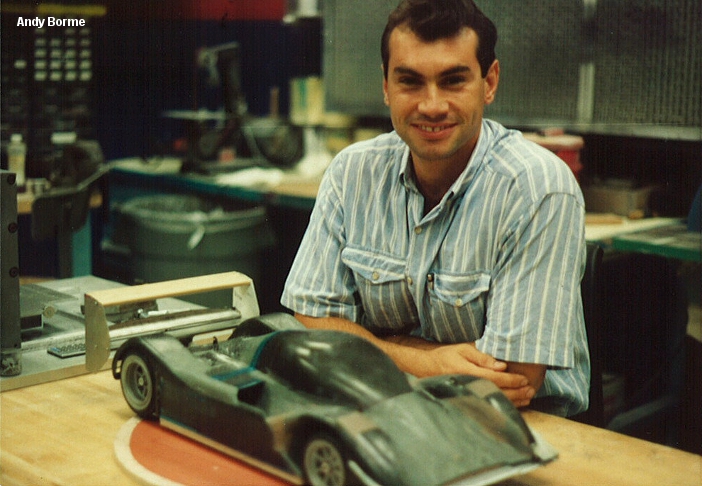 8.22.11 8.22.11
>>A
clearly beaming Andy Borme greets us circa 1992 as he oversees the
aerodynamic development of what would have been the 1993 Nissan GTP.
Borme joined Electamotive in May of 1989, "(I) was employee #39 I
think." Says Borme, "I was really hired to work on the 90 car
with Chris (Willes) as work on that car was ramping up. As a junior
lad I ended up designing, under Trevor’s (Harris) direction of course,
many of the chassis bits, bulkheads, door structure, roll hoop, beams,
radiator, windshield washer, brake hats, etc., that made the car.
Tons of drawings to do with few people to do them..."
Nissan
purchased the team in 1990 and Electramotive then became Nissan
Performance Technology, Inc. (NPTI). And subsequently the
organization began to expand. At the height there would be
upwards of 250 employees deployed across a 5 buidling "campus" that
covered design, engineering, aerodynamics, manufacturing, engine
development, you name it! Name an American racing organization
can do that now, much less in as technically advanced category as IMSA
GTP was during its era?
With Dick Yagmi's departure from NPTI
in late 1990, Borme was directed to take over the aero
development of the 1991 car, "So this 26 year old new grad was given a
windtunnel and two model makers and freedom to create. Fantastic
and frightening. What do I do now!?"
| 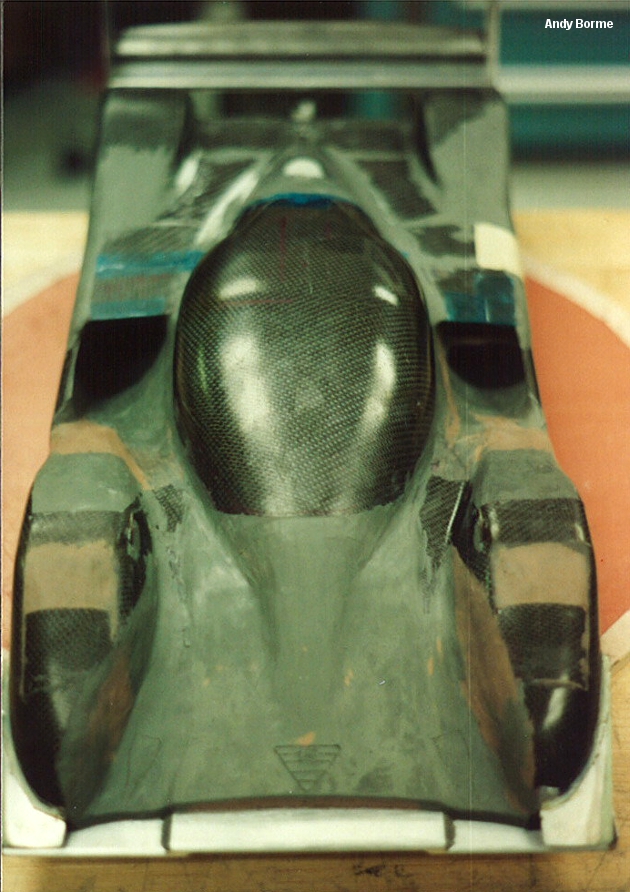 The propsed 1993 Nissaan IMSA GTP car started with the Nissan P35 as
a general basis, though it very quickly evolved in a different
direction. Which is understandable given the very different
cooling requirements for the proposed single turbo V6. Going
into the 1992 season it had become evident that the IMSA regulations
favored the
smaller capacity turbos and the matrix of downforce vs. weight vs.
engine capacity seemed to show the way. Toyota showed the way
with its 2.1 liter, turbo 4-cylinder. And throughout 1992 NPTI
worked dillegently to rework the NPT-90 in order to shave weight out of
the car. In the end they found nearly 200 lbs of weight
reduction, but ultimately the NPT-90 wasn't an optimized car.
Thus with the NPT-93 Nissan set out to design from scrach an
optimized car. The propsed 1993 Nissaan IMSA GTP car started with the Nissan P35 as
a general basis, though it very quickly evolved in a different
direction. Which is understandable given the very different
cooling requirements for the proposed single turbo V6. Going
into the 1992 season it had become evident that the IMSA regulations
favored the
smaller capacity turbos and the matrix of downforce vs. weight vs.
engine capacity seemed to show the way. Toyota showed the way
with its 2.1 liter, turbo 4-cylinder. And throughout 1992 NPTI
worked dillegently to rework the NPT-90 in order to shave weight out of
the car. In the end they found nearly 200 lbs of weight
reduction, but ultimately the NPT-90 wasn't an optimized car.
Thus with the NPT-93 Nissan set out to design from scrach an
optimized car.
Initially
the Nissan P35’s tub and suspension were to be retained to form the
basis for the NPT-93 chassis. The idea was that the P35 tub would
have been replaced by a purpose built unit incorporating a raised foot
box to allow for a greater scope of front-end downforce
generation. Various areas of the car were to be beefed up and
ultimately the NPT-93 would have weighed much more than the P35 basis
given IMSA’s regulations. The NPT-93 was to use the final
single-turbo version of the Nissan GTP motor in place of the P35’s
gutless V12. A 6-speed gearbox, similar to the unit in the NPT-90
GTP car, would also have been used. The engine’s single turbo was
to have been located in the gearbox’s integral bellhousing with the
starter motor just below the turbo and accessible via a hatch in the
underfloor.
"With over 10,000 lbs of DF and an L/D of 6:1 we were all
pretty excited to take it to the Toyotas. We took all the lessons
learned from the 90 car work and also found, and this is quite
important, that moving the radiators away from the front and thereby
having a clean nose section without holes gave a significant
improvement in L/D. In fact the nose shape was quite insensitive
which is why I sculpted the curved shape for styling. We
introduced large front tunnels just inboard of the front wheels which
exited behind the wheels in the large opening. It had a permanent
step in the floor to prevent porpoising. We also found another
large efficiency and downforce gain by raising the bodywork height in
the middle and lowering it at the trailing edge leading to a very
low mounted rear wing."
It
has been said that at the peak Nissan was spending nearly $25 million a
year (1992 dollars--$40-$60 million in today's money) on their GTP effort. But the price of competing began to be
a diminishing return for Nissan in the face of the amounts spent vs.
the results. The faltering Japanese economy didn’t improve the
situation either. As such the NPT-93 would never see the race
track. On March 29th 1993, NPTI closed its doors for good.
"We were a collection of very good people and it was a sad day when we were
disbanded.
I am still friends with many of the people who worked there.
Trevor came to visit me in Cologne, Germany last year.
Brian still lives in Indy. I saw Chris Norris at the IMIS
show and at Swift this year. Peter Scott and I worked together
again at Hogan Racing in 1999. When many of us moved to Indycars,
which was the other hot show in town, they were not happy to see us as
we flooded the market with good people, bringing salaries down.
(It was) a time that will not soon be replicated."
|  | 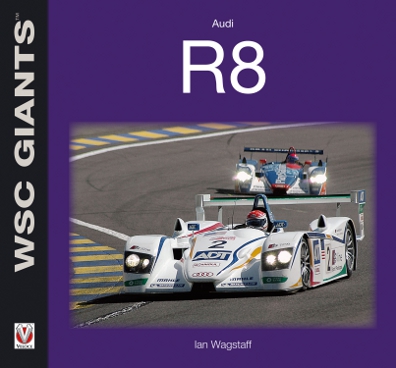 8.17.11 8.17.11
>>Ian
Wagstaff has written a new book on the Audi R8 as part of Veloce Publishing's "WSC
Giants" series. The book details the R8's
success from R8R & R8C in 1999, to R8 and its final races in 2006. The book
covers all 80 races as well as individual chassis histories.
It also features profiles on all 35 drivers who raced an R8 in
their career. 115 color and black & white images, 128 pages. Release is set for next month and the book can be
ordered through Veloce Publishing or Amazon.com. | | 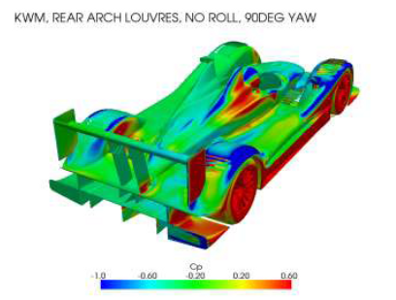 8.12.11 8.12.11
>>IMSA has issued Competition Bulletin #11-19
that mandates an increase in the louver area over the front wheels,
from 160 cm^2 to 260 cm^2 (an increase in area of about 60%), starting
September 1 of this year. 11-19 also recommends louvers over the rear fenders (100 cm^2) though mandates them from January 1, 2012.
Rear
louvers were part of the initial Delta Motorsports yaw study conducted
for the FIA, as far back as 2009. The louvers help by reducing
lift at the extents of the car's plan area. And in general, it
has been found that any device that does that, helps reduce the
sensitivity to sudden-yaw induced blow overs. Apparently interest
has recently been renewed in their implementation following a test
series conducted by Peugeot. | 
| 7.26.11
>>Last week Level 5 Racing announced
a switch from their Lola LMP2s to HPD ARX-01gs, starting at
Silverstone. With the announcement of an -01g from Wirth
Research, our efforts turned to determine what exactly a -01g is.
The press release gives the basics, the -01g is a cost capped
-01d. That means Level 5 will be able to run with more power,
less weight (20 kgs less), and higher refueling flow rates, than the
RML and Strakka -01ds as ACO rules have heavily penalize non-cost
capped chassis'. But Nick Wirth was surprisingly reticent
to talk -01g details, "Not yet...." is all he would elaborate when
asked.
The exterior shape and the "hard bits" (engine, gearbox, tub, suspension, uprights, brakes, etc.) of the -01g are
identical to the non-cost capped -01d. And some inquiring has
determined at very least the -01g will have cast wheels and a reduced
data system. The cast wheels in deference to cost-cap
regulations. We also understand that some details will be
simplified to reduce cost. For example, the standard HPD utilizes
two alternators (a primary and a backup) and the -01g will more than
likely only have one.
On an aside, we noted that one ARX-01
marque had been skipped. The ARX-01f. When asked, Wirth did
offer this, "A space in the designation cycle has been left for future
P1 developments..." |  | 7.24.11
>>At the Lime Rock ALMS round, Speed TV's John Dagy's detailed some of the changes on the Dyson B09/86 Lola Mazdas. These changes amount to upgrading the #16 to 2011 B11/80 long wheelbase specification. There's quite a bit of difference in the rear aero between the two cars and we thought we'd have a look at that.
| | 7.19.11
>>A
rumor is making the rounds about the direction the ACO's 2014
regulations will take. It is our understanding that a outline is
being passed amongst the teams and manufacturers that proposes what
effectively is a fuel energy content formula to start in 2014.
The proposal allots 1500 liters of gasoline, or alternate fuel
equivalent (diesel, methanol, etc.), for Le Mans. The energy
content equivalency volume would be determined by the ACO. For a
historical reference, in 1990, Group C1 cars were alloted 2450 liters
for Le Mans. C2 cars were allowed 1650 liters. But most
interestingly, the 2014 proposal allows for the complete freeing up of
the engine regulations. But we can imagine the comparative
draconian fuel allotment (compared to C1 in 1990) will drive engine
capacities down not too far from what's being seen today.
Obviously hybrid technology would play right into this as well.
No mention is being made at the moment regarding chassis regulations. | 
| 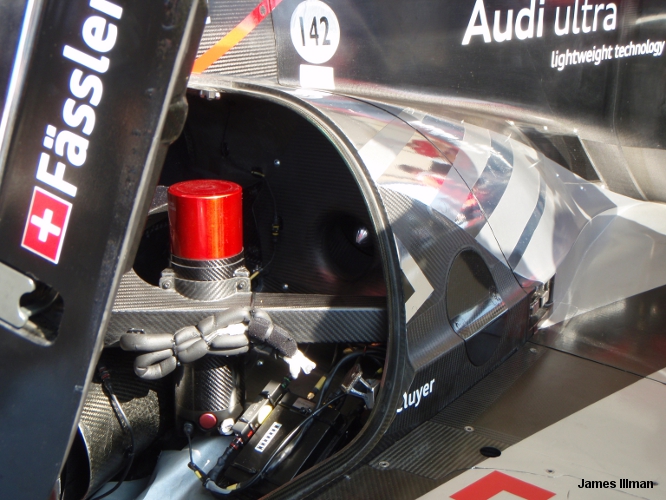 7.9.11 7.9.11
>>Audi's
R18 made the necessary appearance at Goodwood this past weekend.
And from that we've received a shot of the cockpit showing the
engine bay cooling intake in the face of the rear bulkhead of the
monocoque. It would be interesting to know where the opposite
side intake is. From the photos of the ducting routing through
the engine bay, the ducts appear to be symmetrical about the car
centerline, which would presumably put the driver side intake just
above the right shoulder. |  It would appear that the silver bullet fairing is a motorized fan to help draw airflow rearwards. It would appear that the silver bullet fairing is a motorized fan to help draw airflow rearwards. | 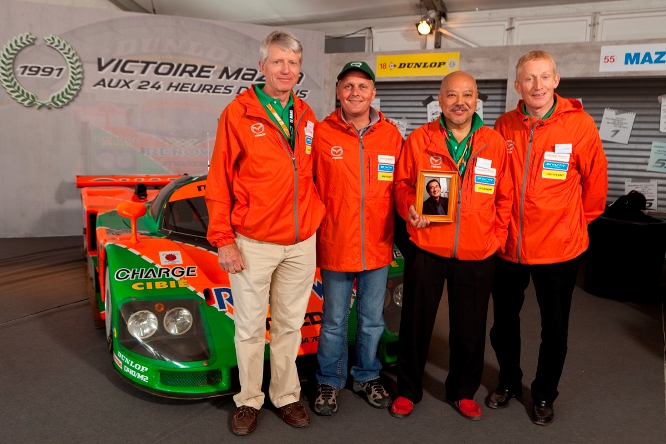 >>By
now you've perhaps seen the fantastic on-board video of Johnny
Herbert's demonstration lap in the Mazda 787B at Le Mans for Mazda's
20th anniversary of their 1991 win? If not, here it is again.
Watching the video prompted an email to the always helpful Mr.
Pierre Dieudonne. Mr. Dieudonne drove one of the sister 787Bs
(#56) in 1991, co driving with Yojiro Terada and Takashi Yorino. >>By
now you've perhaps seen the fantastic on-board video of Johnny
Herbert's demonstration lap in the Mazda 787B at Le Mans for Mazda's
20th anniversary of their 1991 win? If not, here it is again.
Watching the video prompted an email to the always helpful Mr.
Pierre Dieudonne. Mr. Dieudonne drove one of the sister 787Bs
(#56) in 1991, co driving with Yojiro Terada and Takashi Yorino.
I
was very curious how fast Herbert got the old 787B up to.
Watching him into the first chicane and the car is in top gear
and approaching maximum revs. Dieudonne caught up with Herbert
following the Le Mans 20th outing and passed along, "Yes, I spoke with
Johnny at the Nürburgring and he confirmed he was flat out on the
Mulsanne, with plenty of revs! Therefore, we can safely assume he
was traveling over 300 km/h… Not bad for an old lady (I mean the 787B,
not Johnny…"
Incidentally, the picture at right shows Mr.
Dieudonne with fellow drivers Johnny Herbert, Yojiro Terada, and Dave
Kennedy. The gentleman in the framed picture is the late Mr.
Takayoshi Ohashi, the Managing Director of the Mazdaspeed effort in
1991. As Mr. Dieudonne lamented, "He really was a major key
person in the whole story (I mean THE key person, in my opinion).
It also came as a real personal blow for me because he was the
leading force of an important and long chapter of my own life and I had
lots of respect for him." Mr. Ohashi passed away in 2009. | | 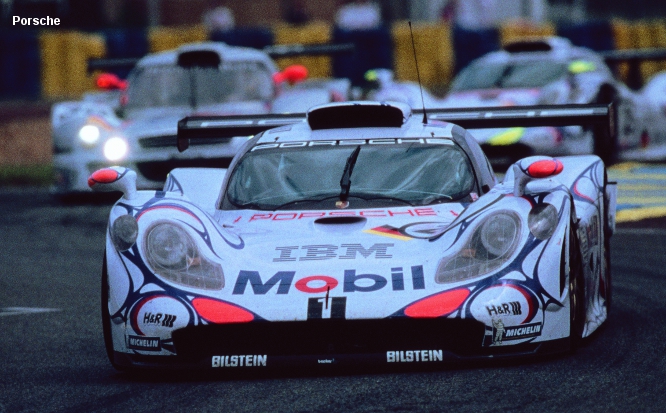 7.1.11 7.1.11
>>The
presumption has always been that with Audi's participation in LMP
racing Porsche, also under the VAG umbrella, was forbidden to join the
fray. One only has to recall the canceled Porsche LMP2000.
And while it always "made sense" for Porsche to be involved at
the top level, the reality has been for the past 13 years that they
simply weren't. Well that's all changed. Yesterday Porsche
announced(1 & 2) that they will return to Le Mans in 2014 in and LMP1.
You'll
note that 2014 coincides with time-tabled, though as yet still
undefined (undefined for us, one can bet Porsche has certain assurances), regulation changes. But one thing is certain, Porsche
will be very keen to utilize their now emerging hybrid technology.
So in what definitive form Porsche's prototype challenger will
emerge naturally will remain to be seen for some time. We
understand Porsche aerodynamicist Michael Pfadenhauer will have a hand
in the new car. File that under obvious...
Lacking further details, at the moment the most interesting question is where this will leave Audi in the future. One
wonders about the timing of Porsche's announcement given yesterday's
FIA announcement regarding the future engine program for Formula One.
Is this the fruit of the FIA/ACO relationship blooming already
only one month in, or paranoid delusions? Porsche to Le Mans,
Audi to F1? Evidence suggests otherwise. And Audi's own comments
mirror this thought, "This is the decision of Porsche company, a
decision in which Audi is not involved. Audi relishes the prospect of
every strong new opponent at
Le Mans." We've added that last emphasis. Could we see Audi
and Porsche competing side by side at Le Mans in 2014, something denied
for the past 13 years? But perhaps the greater question begs,
what's left for Audi to prove?
|

|
 |
Aerodynamicist
and automotive enthusiast Paul T. Glessner presents "The Secrets
&
Basics of Vehicle Aerodynamics" Seminars. See why more cars
are going
faster and doing it more safely and in style. Paul has been
asked
to speak at venues like Bob Bondurant School of High Performance
Driving,
Society of Automotive Engineers (SAE), Specialty Equipment Marketing
Assoc.
(SEMA), and Performance Racing Industry (PRI). Paul's
seminars both
educate and entertain. The day long seminar can be held at
your club,
organization and/or company location with the organizer paying only
$100.
(click event date in site) to read
about Paul's
extensive background and testimonials from enthusiasts like Jay
Leno.
Schedule your seminar at www.aeroseminars.com!
|
|
"While
I am not an engineer or a major technical type, I enjoy the discipline
of aerodynamics and was pleased at how Paul was able to explain its
intricacies
to individuals like me." - Jay Leno, Tonight Show Host |
|
|

